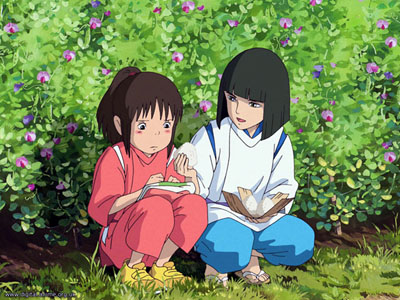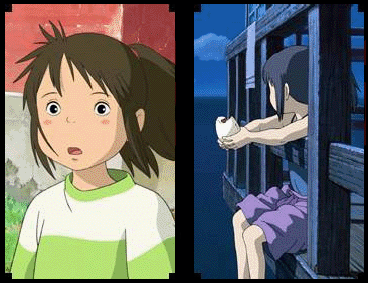Development of Ideas and Structure in Moving Image.
Key Principles:
- Character Design
- Digital Storytelling
 To further describe the principle of character design, I have selected the character of ‘Chihiro’ from the Hayao Miyazaki/Studio Ghibli film ‘Spirited Away’ (Original title ‘Sen to Chihiro no Kamikakushi’) as I feel she is an unusual protagonist when compared with western character design in both film and television. As with other works by the company, the use of a young female lead is a refreshing change from male ‘action-hero’ types so commonly found in many aspects of modern animation, television and film.
To further describe the principle of character design, I have selected the character of ‘Chihiro’ from the Hayao Miyazaki/Studio Ghibli film ‘Spirited Away’ (Original title ‘Sen to Chihiro no Kamikakushi’) as I feel she is an unusual protagonist when compared with western character design in both film and television. As with other works by the company, the use of a young female lead is a refreshing change from male ‘action-hero’ types so commonly found in many aspects of modern animation, television and film. Chihiro is unremarkable, initially her visual presence accurately conveying that of a modern child, with an oversized t-shirt, suggesting she is not in a hurry to grow up, along with shorts and Dorothy-style red shoes. It is this normality that we are able to relate with, following the often-used technique of presenting an average person as someone who is able to become stronger and wiser through the course of their actions and subsequent reflections. As the film progresses, her attire changes to match her role as an average bathhouse worker, yet is a passionate red hue.
 The premise of the film revolves around Chihiro reluctantly moving to a new town with her parents whilst being their continuous source of exasperation due to her sullen attitude to the excursion. This however, builds audience empathy as her personality is built with such realism, complimented by the finely detailed and true-to life animation style of all of the Ghibli works. Initially the character is timid and afraid as she is absorbed into a world of traditional Japanese monsters and spirits but after a friendly interaction with a spirit boy named Haku, she is able to overcome her fear of the unknown and eventually build up the courage to begin an escape from the strange world. At first she seems resigned to her fate of remaining trapped, but through the establishment of friendships and consequent fearlessness, she overcomes her selfish nature and realizes how her actions affect others and herself.
The premise of the film revolves around Chihiro reluctantly moving to a new town with her parents whilst being their continuous source of exasperation due to her sullen attitude to the excursion. This however, builds audience empathy as her personality is built with such realism, complimented by the finely detailed and true-to life animation style of all of the Ghibli works. Initially the character is timid and afraid as she is absorbed into a world of traditional Japanese monsters and spirits but after a friendly interaction with a spirit boy named Haku, she is able to overcome her fear of the unknown and eventually build up the courage to begin an escape from the strange world. At first she seems resigned to her fate of remaining trapped, but through the establishment of friendships and consequent fearlessness, she overcomes her selfish nature and realizes how her actions affect others and herself. In order to demonstrate the digital storytelling prinicple, I have selected the Harry Potter brand, which spans over an astonishing range of media and franchises in order to further engage the audience and therefore widen commercial prospects.
In order to demonstrate the digital storytelling prinicple, I have selected the Harry Potter brand, which spans over an astonishing range of media and franchises in order to further engage the audience and therefore widen commercial prospects.Although 8 films have been produced from the original book series, the covers of which were illustrated traditionally; the progression of the story as a mega-brand has been aided by the use of Warner Brother’s official website (screencapped right), which can also be found here.
 As the plot revolves around a fantasy world, the series is incredibly visually-orientated; designed to leave audiences with a sense of escapism and amazement. This is continued on the flash-laden website, with dramatic film stills and promotional photographs taking centre stage in layout and thus promotion. The site changes with every upcoming Potter Film release in order to gain viewers through visual information and interactivity with audience. For example, the web viewer can truly feel a part of the series by uploading their own photograph into a Potter-style newspaper article (above left), or download an app for their Iphone; something that may be of interest to older viewers. It is this multi-layered use of differing media including such broad interactivity that truly brings the viewer into a fantasy world, engaging them and thus enticing them to view the films, buy the merchandise, and spend their money.
As the plot revolves around a fantasy world, the series is incredibly visually-orientated; designed to leave audiences with a sense of escapism and amazement. This is continued on the flash-laden website, with dramatic film stills and promotional photographs taking centre stage in layout and thus promotion. The site changes with every upcoming Potter Film release in order to gain viewers through visual information and interactivity with audience. For example, the web viewer can truly feel a part of the series by uploading their own photograph into a Potter-style newspaper article (above left), or download an app for their Iphone; something that may be of interest to older viewers. It is this multi-layered use of differing media including such broad interactivity that truly brings the viewer into a fantasy world, engaging them and thus enticing them to view the films, buy the merchandise, and spend their money.
No comments:
Post a Comment